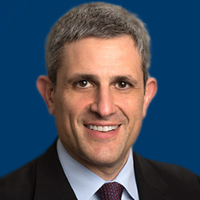Commentary
Video
Dr Yap on Saruparib in BRCA1/2+, PALB2+, or RAD51C/D+ Advanced Solid Tumors
Author(s):
Timothy Yap, MBBS, PhD, FRCP, discusses data for saruparib in harboring BRCA1/2, PALB2, or RAD51C/D mutations.
Timothy Yap, MBBS, PhD, FRCP, medical oncologist and physician-scientist; professor, Department for Investigational Cancer Therapeutics (Phase I Program), Department of Thoracic/Head and Neck Medical Oncology; vice president, head of clinical development, Therapeutics Discovery Division; and associate director of translational research, Khalifa Institute for Personalized Cancer Therapy, The University of Texas MD Anderson Cancer Center, discusses safety and efficacy data from the phase 1/2a PETRA trial (NCT04644068) investigating the first-in-class PARP1 inhibitor saruparib (AZD5305) as a treatment for patients with advanced solid tumors harboring BRCA1/2, PALB2, or RAD51C/D mutations.
Part A of the first-in-human study included patients with HER2-negative breast cancer, ovarian cancer, prostate cancer, and pancreatic cancer who had not received more than 1 prior PARP inhibitor. Part B1 consisted of patients with HER2-negative breast cancer who were naive to PARP inhibitors; however, there was no limit on prior chemotherapy lines in the metastatic setting for these patients.
In part A, saruparib was administered at doses ranging from 10 mg to 140 mg once daily. In part B, the PARP1 inhibitor was given at 20 mg, 60 mg, or 90 mg once per day.
Findings presented at the 2024 AACR Annual Meeting showed that patients with HER2-negative breast cancer treated with 20 mg of saruparib in part B1 experienced a median best change in tumor size of –22.1% (range, –91.2% to 133.3%), an overall response rate (ORR) of 35.7% (80% CI, 23.5%-49.6%), and a median progression-free survival (PFS) of 4.6 months (80% CI, 3.7-5.4). In patients treated with 60 mg of the PARP1 inhibitor, the median best change in tumor size was –34.6% (range, –100% to 43.2%), the ORR was 48.4% (80% CI, 35.7%-61.3%), and the median PFS was 9.1 months (80% CI, 5.7-9.3).
Yap explains that treatment was generally well tolerated, and the majority of adverse effects were grade 1 or 2. He notes that rates of dose reductions, dose interruptions, and treatment discontinuations were lower than historical data for first-generation PARP inhibitors.
Significant pharmacodynamic effects were observed with over 90% PARP1 inhibition in both peripheral blood mononuclear cells and tumor biopsies, Yap says.
On top of the responses observed in part B1 of the study, responses were generated during dose escalation across all dose levels. These findings informed the decision to proceed to dose optimization in patients with HER2-negative breast cancer, he adds.









